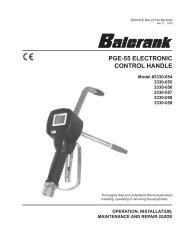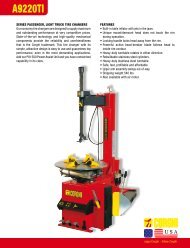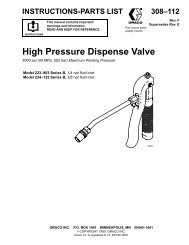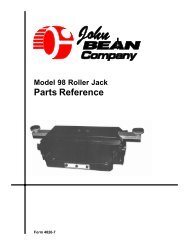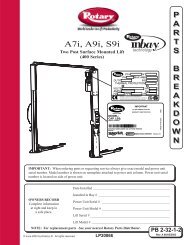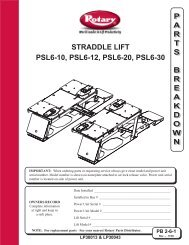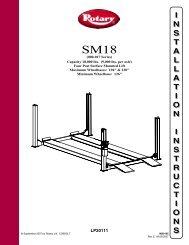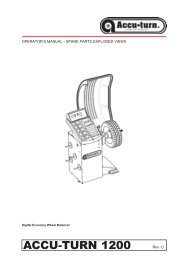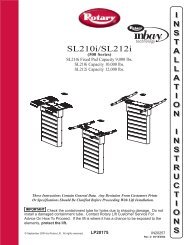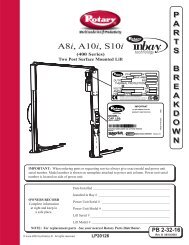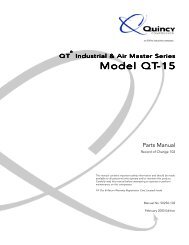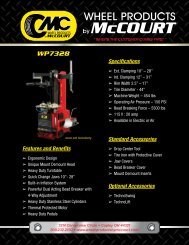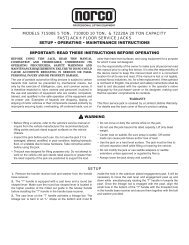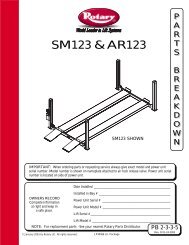YA12 - Flamingo Shop Serv
YA12 - Flamingo Shop Serv
YA12 - Flamingo Shop Serv
You also want an ePaper? Increase the reach of your titles
YUMPU automatically turns print PDFs into web optimized ePapers that Google loves.
TABLE OF CONTENTS:<br />
Owner/Employer Responsibilities ...................................................... 2<br />
Safety Instructions ............................................................................... 2<br />
Operating Instructions ......................................................................... 4<br />
Maintenance Instructions ................................................................... 6<br />
Trouble Shooting ................................................................................... 7<br />
Manual Raising & Lowering Runways .............................................. 12<br />
Calibration Procedure .......................................................................... 15<br />
Lift Lockout/Tagout Procedure ........................................................... 18<br />
Operating Conditions ............................................................................ 19<br />
Approved Accessories......................................................................... 19<br />
© October 2009 by Rotary Lift. All rights reserved. CO7455.7<br />
<strong>YA12</strong><br />
SURFACE AND FLUSH MOUNTED LIFT<br />
(000 SERIES)<br />
12000 lb. Capacity<br />
(6000 lbs. per axle)<br />
LP20508<br />
OM20207<br />
Rev. - 10/24/2009<br />
O PERATION<br />
&<br />
M AINTENANCE<br />
M ANUAL
• The Owner/Employer shall ensure that lift operators are qualified and that they are trained in the safe use and operation of the lift<br />
using the manufacturer’s operating instructions; ALI/SM 93-1, ALI Lifting it Right safety manual; ALI/ST-90 ALI Safety Tips card;<br />
ANSI/ALI ALOIM-2008, American National Standard for Automotive Lifts-Safety Requirements for Operation, Inspection and Maintenance;<br />
ALI/WL Series, ALI Uniform Warning Label Decals/Placards; and in the case of frame engaging lifts, ALI/LP-GUIDE, Vehicle<br />
Lifting Points/Quick Reference Guide for Frame Engaging Lifts.<br />
• The Owner/Employer shall establish procedures to periodically inspect the lift in accordance with the lift manufacturer’s instructions<br />
or ANSI/ALI ALOIM-2008, American National Standard for Automotive Lifts-Safety Requirements for Operation, Inspection and<br />
Maintenance; and The Employer Shall ensure that lift inspectors are qualified and that they are adequately trained in the inspection<br />
of the lift.<br />
• The Owner/Employer shall establish procedures to periodically maintain the lift in accordance with the lift manufacturer’s instructions<br />
or ANSI/ALI ALOIM-2008, American National Standard for Automotive Lifts-Safety Requirements for Operation, Inspection and<br />
Maintenance; and The Employer Shall ensure that lift maintenance personnel are qualified and that they are adequately trained in<br />
the maintenance of the lift.<br />
• The Owner/Employer shall maintain the periodic inspection and maintenance records recommended by the manufacturer or ANSI/<br />
ALI ALOIM-2008, American National Standard for Automotive Lifts-Safety Requirements for Operation, Inspection and Maintenance.<br />
• The Owner/Employer shall display the lift manufacturer’s operating instructions; ALI/SM 93-1, ALI Lifting it Right safety manual; ALI/<br />
ST-90 ALI Safety Tips card; ANSI/ALI ALOIM-2008, American National Standard for Automotive Lifts-Safety Requirements for Operation,<br />
Inspection and Maintenance; and in the case of frame engaging lifts, ALI/LP-GUIDE, Vehicle Lifting Points/Quick Reference<br />
Guide for Frame Engaging Lifts; in a conspicuous location in the lift area convenient to the operator.<br />
• The Owner/Employer shall provide necessary lockout/tagout means for energy sources per ANSI Z244.1-1982 (R1993), Safety Requirements<br />
for the Lockout/Tagout of Energy Sources, before beginning any lift repairs.<br />
• The Owner/Employer shall not modify the lift in any manner without the prior written consent of the manufacturer.<br />
• Daily inspect your lift. Never operate if it malfunctions or if it<br />
has been broken or damaged parts. Use only qualified lift service<br />
personnel and genuine Rotary parts to make repairs.<br />
• Thoroughly train all employees in the use and care of lift and<br />
wheels free device, using manufacturer’s instructions and “Lifting<br />
It Right” and “Safety Instructions” supplied with the lift.<br />
• DO NOT permit employees or customers on lift when it is either<br />
being raised or lowered.<br />
• Never allow unauthorized or untrained persons to operate lift or<br />
wheels free device.<br />
• Prohibit customers or non-authorized persons from being in<br />
shop area while lift is in use.<br />
• DO NOT stand in front or behind lift while vehicle is being driven<br />
onto or backed off the lift.<br />
• Load vehicle on lift carefully, align vehicle with runways before<br />
driving on.<br />
The Owner/Employer:<br />
SAFETY INSTRUCTIONS<br />
2<br />
• DO NOT allow rear tires or portion of vehicle to interfere with<br />
ramp/chocks.<br />
• Never allow front wheels to strike the front wheel stops.<br />
• Never raise or lower the lift while the vehicle is supported by the<br />
wheels free device. Only raise or lower the lift when all 4 tires of<br />
the vehicle are supported by the runway.<br />
• Always stand clear of lift when raising or lowering and observe<br />
“Pinch Points” Warning.<br />
• Never overload lift: capacity of lift is 12,000 lbs. (6,000 lbs. per<br />
axle.) CAPACITY SHOULD NOT BE EXCEEDED.<br />
• Always engage parking brake and use the rear wheel chocks to<br />
keep the vehicle from rolling freely on the runways.<br />
• Always lower lift on locks before working on vehicle.<br />
CAUTION If you are working under vehicle, lift should be<br />
raised high enough for locking latches to engage.
• Always keep area around lift clean of tools, debris, grease, and<br />
oil.<br />
• Always keep runway clean.<br />
• Replace all caution, warning, or safety related decals on the lift<br />
when unable to read or missing.<br />
• For Wheels Free Device Safety Instructions see Wheels Free<br />
Device Installation, Operation and Maintenance Instructions in<br />
the wheels free device box.<br />
• Never use work step while lift is in a raised position.<br />
• DO NOT perform any maintenance on the power unit, control<br />
valves, air or fluid lines, hydraulic cylinders, or check fluid level<br />
until lift has been fully lowered and all pressure has bee released<br />
from system. Follow OSHA Lockout/Tagout procedures as they<br />
apply, reference ANSI Z244.1.<br />
SAFETY<br />
INSTRUCTIONS<br />
Read operating<br />
and safety manuals<br />
before using lift.<br />
CAUTION<br />
? ?<br />
?<br />
Lift to be used<br />
by trained operator<br />
ONLY.<br />
WARNING<br />
Chock wheel<br />
to prevent<br />
vehicle movement.<br />
©<br />
©<br />
©<br />
SAFETY<br />
INSTRUCTIONS<br />
Do not operate<br />
a damaged lift.<br />
WARNING<br />
Remain clear of lift<br />
when raising or<br />
lowering vehicle.<br />
SAFETY INSTRUCTIONS<br />
©<br />
©<br />
SAFETY<br />
INSTRUCTIONS<br />
Proper maintenance<br />
and inspection<br />
is necessary<br />
for safe operation. ©<br />
WARNING<br />
Keep clear<br />
of pinch points<br />
when lift is moving.<br />
3<br />
• DO NOT block open or override self-closing lift controls, they are<br />
designed to return to the off or neutral position when released.<br />
• Clean area if vehicle is in danger of falling.<br />
• Remove tools, and other equipment from on or below lift before<br />
lowering lift.<br />
CAUTION Lowering lift legs onto an obstruction may cause<br />
damage to lift.<br />
©<br />
WARNING<br />
Clear area if vehicle<br />
is in danger of falling.<br />
WARNING<br />
Keep feet<br />
clear of lift<br />
while lowering.<br />
©<br />
©<br />
CAUTION<br />
Authorized personnel<br />
only in lift area.<br />
WARNING<br />
Do not override<br />
self-closing<br />
lift controls.<br />
©<br />
©
WARNING To avoid personal injury and/or property damage,<br />
permit only trained personnel to operate lift.<br />
IMPORTANT Always lift vehicle using all four tires. Never<br />
raise just one end, corner or one side of vehicle.<br />
After reviewing these instructions, get familiar with lift controls by<br />
running the lift through a few cycles before loading vehicle on lift.<br />
WARNING If lift is not operating properly, DO NOT use until<br />
adjustments or repairs are made by a qualified lift service<br />
technician.<br />
Observe and heed SAFETY and WARNING labels on the lift.<br />
NOTE: This lift was designed for 121-1/2” or longer wheelbase at<br />
the rated 12,000 lb.<br />
1. Loading:<br />
A. Lift must be fully lowered and service bay clear of all<br />
personnel before the vehicle is brought on lift. Do not<br />
stand in front of a moving vehicle.<br />
B. If lift is equipped with wheels free device, it must be fully<br />
lowered and the rear wheels free device pushed toward<br />
center of lift to provide under car clearance.<br />
C. Stop vehicle when it contacts the front wheel stops.<br />
At all times, be sure rear wheels are forward of<br />
the ramp/chocks and the ramp/chocks will clear tires<br />
when the lift is raised, Fig. 1. Driver and passengers<br />
must exit before raising.<br />
D. Place triangular wheel chocks on each side of one of the<br />
rear tires, Fig. 1.<br />
2. To Raise Lift:<br />
A. Push the “RAISE” button on the control panel. Release<br />
button at desired height, Fig. 2.<br />
B. Lower lift to locking latches by pushing the “LOWER TO<br />
LOCKS” button until light turns off, Fig. 2.<br />
IMPORTANT Always lower lift on locking latches before alignment<br />
readings are measured.<br />
C. For Wheels Free Device Operating Instructions see<br />
Wheels Free Device Installation, Operation and Mainte-<br />
nance Instructions in the wheels free device shipping<br />
carton.<br />
CAUTION DO NOT go under vehicle or lift if locking latches<br />
are not engaged.<br />
OPERATING INSTRUCTIONS<br />
4<br />
WARNING Never raise lift while vehicle is supported<br />
above the runway by the wheels free device.<br />
3. Before Lowering Lift:<br />
A. Be sure no one is in the lift area and that all tools, tool<br />
trays, etc. have been removed from under the lift and<br />
vehicle.<br />
WARNING Observe pinch point warning decals, Fig. 3.<br />
B. If lift is equipped with wheels free device, it must be fully<br />
lowered and the rear wheels free device pushed toward<br />
center of lift to provide under car clearance.<br />
4. To Lower Lift:<br />
A. Raise lift off locking latches by pushing the “RAISE”<br />
button, Fig. 2.<br />
Note: If actuator on air valve is released, the latches will automatically<br />
reset to the engaged position.<br />
B. Push the “Lowering” button to lower lift, Fig. 2.<br />
C. Observe lift and vehicle to be sure lift is level while being<br />
lowered. If not, STOP raise lift by pressing the “Raise”<br />
button until runways are level and repeat the lowering<br />
process.<br />
D. Fully lower lift, remove the triangular wheel chocks and<br />
check to be sure area is clear before removing vehicle<br />
from lift, Fig. 1.<br />
WARNING Keep hands clear of linkages while the lift is<br />
being raised or lowered, Fig. 3.<br />
WARNING Never lower lift while vehicle is supported<br />
above the runway by the wheels free device.<br />
WARNING Before attempting to lift pick-up trucks or other<br />
truck frame vehicles, be sure that:<br />
A. Vehicle individual axle weight does not exceed one-half<br />
lift capacity.<br />
B. Adequate overhead clearance is provided to raise<br />
vehicles to desired height.<br />
Note: Allow 2 seconds between motor starts. Failure to comply<br />
may cause motor burnout.
Control Fault<br />
Beeper<br />
Triangular<br />
Wheel Stops<br />
Raise Button<br />
Leg Link<br />
OPERATING INSTRUCTIONS<br />
NP945 REV.-<br />
5<br />
LIFT ON<br />
LOCKS<br />
WHEN LIT<br />
Fig. 1<br />
LOWER TO LOCKS<br />
Fig. 3<br />
Fig. 2<br />
Rear Wheel<br />
Chock<br />
Lower To Locks Button<br />
(Blinks When Lift Is Not<br />
Resting On Locks)<br />
Arm Link<br />
Disconnect Switch<br />
Runway<br />
Hands Clear Warning<br />
Lower Button
WARNING If you are not completely familiar with automotive lift maintenance procedures, STOP. Contact factory for<br />
instructions.<br />
To Avoid Personal Injury, permit only qualified lift service personnel to perform maintenance on this equipment.<br />
• Always: Keep attaching bolts tight.<br />
• Always: Keep locking latches free and oiled.<br />
• Always: Raise lift when cleaning floor area with solvents and/or cleaning compounds.<br />
• Always: Always keep runways and linkages clean. In salt belt or other corrosive environments, the lift must be washed down<br />
weekly.<br />
• Daily: Inspect front wheel stops and ramp/chocks for damage or excessive wear. Replace as required with genuine Rotary Lift<br />
parts.<br />
• Daily: Check locking latch operation and reset. Adjust per instructions or repair if required with genuine Rotary parts.<br />
If locking latch is not heard when lift is raised:<br />
A. Lower loaded lift onto lock, to check if lock is functioning. If lock is functioning, stop. If not, continue on<br />
to “Step B”.<br />
B. Check locking latch for damage or air line problem.<br />
C. Repair and lubricate locking latch pivot points.<br />
D. Lower lift about half way. Then raise lift and watch locking latch operation.<br />
E. The air cylinder should allow locking latch to pivot in and out of the latch bar.<br />
F. Push the “LOWER” button. This should retract air cylinder and locking latch from latch bar in-order to lower<br />
lift.<br />
• Weekly: Clean foreign debris from rear wheel slip plates and turning radius gauges by blowing out with shop air. DO NOT GREASE<br />
BALL BEARINGS.<br />
• Monthly: Check anchor bolts to ensure they are torqued to 90 ft. lbs .<br />
• Monthly: Check level of runway. Adjust per instructions.<br />
• Monthly: Check position sensor cables. Replace if damaged.<br />
• Monthly: Lubricate Guide on each turning radius with a dry film lubricant. Clean and lubricate more often as conditions warrant.<br />
• Semi-Annually: Check fluid level of lift power unit and refill if required. If fluid is required, inspect all fittings, hoses and seals. Repair<br />
as required.<br />
• Semi-Annually: Lubricate slider track channels with Dupont teflon multi-use dry, way lubricant or equivalent PTFE dry film lubricant.<br />
Clean and lubricate more often as conditions warrant.<br />
• Semi-Annually: Lubricate ramp/ chock hinge pins.<br />
MAINTENANCE INSTRUCTION<br />
• For Wheels Free Device Maintenance Instructions see Wheels Free Device Installation, Operation and Maintenance Instructions in<br />
the wheels free device box.<br />
• Replace all caution, warning, or safety related decals on the lift if unable to read or missing. Reorder labels from Rotary Lift - see<br />
parts breakdown.<br />
• Oil Filter Control Manifold: Replace filter after the first 6 months of operation and every 2 years thereafter. Installation torque is hand<br />
tight.<br />
6
Troubleshooting<br />
Description<br />
Lift Stops Short Of Full Rise<br />
Lift Chatters<br />
Cylinder Groaning<br />
Anchors Will Not Stay Tight<br />
Lift Going Up Unlevel<br />
TROUBLE SHOOTING<br />
Low Oil Level<br />
Low Oil Level<br />
Possible<br />
Cause<br />
1. Air in hydraulic system.<br />
2. Dry hydraulic cylinder rod<br />
1. Holes Drilled Oversize<br />
2. Concrete Floor Not Thick Enough<br />
3. Concrete Floor Not Strong Enough<br />
1. Leveling system components not<br />
operating properly<br />
2. Lock obstructed<br />
3. Pinched Or Chafed Position Sensor<br />
Cable<br />
7<br />
Remedy<br />
1. Refill reservoir per the install<br />
instructions and with the<br />
recommended oil grade.<br />
1. Check for leaks.<br />
2. Refill reservoir per the installation<br />
instructions and with the recommended<br />
oil grade.<br />
1. Cycle lift to full stroke.<br />
2. Spray with silicon lubricant.<br />
1. Relocate lift using a new bit to<br />
drill holes. Reference installation<br />
instructions for proper anchoring<br />
method and minimum spacing<br />
requirements.<br />
2. Break out old concrete and re-pour<br />
per lift installation instructions.<br />
3. Break out old concrete and re-pour<br />
per lift installation instructions.<br />
1. Re-calibrate per installation instructions.<br />
2. Check obstructions/locks- the lift<br />
must be raised manually to move<br />
the lift to within operating limits .<br />
Refer to Manually raising and lowering<br />
runways.<br />
3. Check for pinched or chafed position<br />
sensor cable. Use a continuity<br />
tester to check signal wires to<br />
shield fault then each conductor to<br />
another for a fault. Replace cable if<br />
damaged.
Troubleshooting<br />
Description<br />
Lift Going Up Unlevel - Continued<br />
Slow Lifting Speed<br />
Oil Blowing Out Fill-Breather Cap<br />
Lift Slowly Settles Down<br />
Lift Fails To Raise/Lower<br />
TROUBLE SHOOTING<br />
Possible<br />
Cause<br />
Lift Installed On Unlevel Floor<br />
1. Air Mixed With Oil<br />
2. Air Mixed With Oil Suction<br />
3. Low Oil Level<br />
1. Oil Leak/Pump Failure<br />
2. Incoming Motor Voltage Incorrect<br />
3. Vehicle Weight And Balance Not<br />
Within Lift Capacity.<br />
1. Air Mixed With Oil<br />
2. Air Mixed With Oil Suction<br />
3. Oil Return Tube Loose<br />
4. Slider Tracks Dirty Or Obstructed<br />
1. Debris In Check Valve Seat<br />
2. Debris In Hydraulic System Valve Seat<br />
3. Oil Leak<br />
8<br />
Remedy<br />
1. Shim lift to level per installation<br />
instructions. If over 1/2"(13mm) use<br />
grout to shim bases per installation<br />
instructions.<br />
1. Make sure oil is of recommended<br />
grade.<br />
2. Tighten all suction line fittings.<br />
3. Refill reservoir per the maintenance<br />
instructions and with the recommended<br />
oil grade.<br />
1. External oil leak- locate and repair<br />
leak. Internal oil leak- have hydraulic<br />
system serviced by an au-<br />
thorized service representative.<br />
2. Incoming motor voltage incorrect-<br />
contact your local service authority.<br />
3. Use lift only to rated capacity.<br />
1. Change oil using ISOVG32 Hydraulic<br />
Oil or Dexron III ATF.<br />
Hydraulic tank overfilled.<br />
2. Tighten all suction line fittings.<br />
3. Reinstall oil return tube.<br />
4. Clean and coat slider tracks with<br />
Dupont Teflon Multi-Use dry wax<br />
lubricant or equivalent PTFE dry film<br />
lubricant.<br />
1. Clean check valve.<br />
2. Consult installation instructions<br />
for system schematic. Inspect and<br />
clean hydraulic valves as required.<br />
If problem persist, contact your<br />
authorized representative.<br />
3. External oil leak- locate and repair<br />
leak. Internal oil leak- have hydraulic<br />
system serviced by an authorized<br />
service representative.
Troubleshooting<br />
Description<br />
Lift Fails To Raise When Pushing Raise<br />
Button<br />
Lift Fails To Lower When Pushing Lower<br />
Button<br />
Lift Fails To Lower While Pushing<br />
Lower To Locks Button.<br />
TROUBLE SHOOTING<br />
Possible<br />
Cause<br />
1. Control Fault Beeps<br />
2. Raise Button Defective<br />
3. Vehicle Weight And Balance<br />
Not Within Lift capacity<br />
4. Motor Rotation Incorrect<br />
5. Incoming motor voltage<br />
Incorrect Or Insufficient<br />
6. Loose Or Damaged Wiring<br />
7. Blown Fuse<br />
8. Pinched Or Chafed Position<br />
Sensor Cable<br />
1. Control Fault Beeps<br />
2. Lower Button Defective<br />
3. Hydraulic Valves Malfunctioning<br />
4. Velocity Fuses Malfunctioning<br />
1. Control Fault Beeps<br />
2. Lower To Locks Button Defective<br />
3. Hydraulic Valves Malfunctioning<br />
4. Velocity Fuses Malfunctioning<br />
5. Loose Or Damaged Wiring<br />
6. Blown Fuse<br />
7. Pinched or Chafed Position Sensor<br />
Cable<br />
9<br />
Remedy<br />
1. Follow trouble shooting instructions<br />
for fault identification.<br />
2. Replace raise button.<br />
3. Use lift only at rated load.<br />
4. Re-wire motor according to motor<br />
diagram for counter-clockwise<br />
rotation.<br />
5. Contact your local RAI<br />
6. Inspect and repair loose or damaged<br />
wiring.<br />
7. Check for blown fuse.<br />
8. Check for pinched or chafed<br />
position sensor cable. Replace if<br />
necessary.<br />
1. Follow trouble shooting instructions<br />
for fault displayed.<br />
2. Replace lower button.<br />
3. Check electrical connections or<br />
replace hydraulic valve(s).<br />
4. Pressurize lift hydraulically then<br />
use manual override valves to<br />
release hydraulic pressure.<br />
1. Follow trouble shooting instructions<br />
for fault identification.<br />
2. Replace lower to locks button.<br />
3. Check electrical connections or<br />
replace hydraulic valve(s).<br />
4. Pressurize lift hydraulically then<br />
use manual override valves to<br />
release hydraulic pressure.<br />
5. Pressurize lift hydraulically then<br />
use manual override valves to<br />
release hydraulic pressure.<br />
Lower height limit not set.<br />
6. Check for blown fuse.<br />
7. Check for pinched or chafed<br />
position sensor cable. Replace if<br />
necessary.
Troubleshooting<br />
Description<br />
RJ Pump Will Not Start<br />
RJ Pump Starts But Stalls Under Load<br />
RJ Pump Runs But Will Not Lift Load<br />
RJ Pump Runs But Not To Full Rise<br />
RJ Drifts Down - Will Not Hold<br />
TROUBLE SHOOTING<br />
Possible<br />
Cause<br />
1. Insufficient air supply at pump<br />
2. Leak in air supply line<br />
3. Plugged air filter<br />
4. Bad air motor<br />
1. Insufficient air supply at pump<br />
2. Leak in air supply line<br />
3. Plugged air filter<br />
4. Bad air motor<br />
1. Lift loaded beyond capacity<br />
2. External Oil Leaks<br />
3. Internal leakage.<br />
4. Release mechanism damaged or parts<br />
missing.<br />
5. Wrong pump installed on lift.<br />
6. Pump low on fluid<br />
7. Fluid blowing out rear cover of air motor<br />
8. Pump malfunctioning<br />
1. Pump malfunctioning<br />
1. Release mechanism damaged or parts<br />
missing.<br />
2. External leakage<br />
10<br />
Remedy<br />
1. Pump requires 100-120psi at<br />
20cfm.<br />
2. Locate and correct leakage.<br />
3. Remove and install a new filter.<br />
4. Repair or replace air motor.<br />
1. Pump requires 100-120psi at<br />
20cfm.<br />
2. Locate and correct leakage.<br />
3. Remove and install a new filter.<br />
4. Repair or replace air motor.<br />
1. Use lift only to rated capacity.<br />
2. Repair leak, refill reservoir.<br />
CAUTION Do Not overfill reservoir.<br />
Lift must be completely lowered.<br />
3. Have pump serviced by an authorized<br />
service center.<br />
4. Replace damaged or missing parts.<br />
5. Verify pressure rating of pumps<br />
meets pressure requirements of lift.<br />
6. Lower lift and check fluid complying<br />
with MIL-H-5606. Locate and<br />
correct leak. CAUTION: DO NOT<br />
OVERFILL RESERVOIR. Lift must be<br />
completely lowered.<br />
7. Pump piston seal leaking, have<br />
pump serviced by an authorized<br />
service center.<br />
8. Have pump serviced by an authorized<br />
service center.<br />
1. Have pump serviced by an authorized<br />
service center.<br />
1. Replace damaged or missing parts.<br />
2. Locate leak and repair. Refill<br />
reservoir. CAUTION: DO NOT OVER-<br />
FILL RESERVOIR. Lift MUST be<br />
completely lowered.
Troubleshooting<br />
Description<br />
RJ Drifts Down - Will Not Hold -Continued<br />
RJ Lowers Slow Or Not At All<br />
TROUBLE SHOOTING<br />
1. Internal leakage<br />
Possible<br />
Cause<br />
2. Lift locking latch not released<br />
3. Release mechanism damaged or parts<br />
missing<br />
4. Return flow of fluid restricted or blocked<br />
1. Internal return flow restrictor is plugged<br />
Control Fault Identification And Troubleshooting<br />
Beeps Description Troubleshooting Steps<br />
3 Stuck Key A stuck button has been detected on startup, or a<br />
motion button has been held down for longer than 2-1/2<br />
minutes.<br />
4 Out of Level Runways can not maintain level synchronization<br />
1) Check for runways hung up on the safety<br />
locks.<br />
2) Check for leaks in hydraulic lines.<br />
3) Check for obstructions.<br />
4) Check for overloading.<br />
The system will halt motion and alert the user if the<br />
lift starts to go out of level. Motion will resume on<br />
the next button command. If the runways reach<br />
out-of-level threshold, the lift will shut down until<br />
level is restored using manual lowering procedure.<br />
5 Calibration Error Position sensors are not properly calibrated. Refer to<br />
Operation and Maintenance Manual for calibration<br />
procedure.<br />
6 Position Sensor Error An error has occurred with the position sensor, and<br />
synchronization can no longer be guaranteed. Follow<br />
manual lowering procedures.<br />
7 Short Circuit Detected A short has been detected in the lift actuators. To<br />
determine the faulty component, press the buttons<br />
below in exact order until the error is generated:<br />
1) Up button (Error? Check/replace contactor)<br />
2) Lower to locks (Error? Check/replace hydraulic<br />
valves).<br />
3) Down button (Error? Check/replace air valve<br />
solenoid).<br />
8 CPU error The processor has detected an error. If the problem<br />
continues, call for service.<br />
11<br />
Remedy<br />
1. Have pump serviced by an authorized<br />
service center.<br />
2. Release locking latch.<br />
3. Replace damaged or missing parts.<br />
4. Eliminate blockage. WARNING If<br />
wheels free device is the raised<br />
position, be sure to engage the<br />
mechanical locking device prior to<br />
attempting to service the unit. Failure<br />
to do so may cause lift to lower.<br />
1. Replace damaged or missing parts.
Manually Raising Runways:<br />
Manually Raising And Lowering Runways<br />
To manually raise the lift, the proportional valves (labeled<br />
SV3 and SV4) will have to be opened, by rotating<br />
the knobs by hand, to allow fluid to flow to the hydraulic<br />
cylinders. A hand pump (not included with the lift,<br />
Rotary Part # N827) will need to be attached to the HP<br />
port on the front of the block.<br />
The proportional valves and hand pump port are located<br />
on the control manifold, next to the motor and inside<br />
the cabinet, see Fig. 4. Access to this area is gained<br />
by removing the back panel on the control cabinet, see<br />
Fig. 5.<br />
IMPORTANT When raising the lift manually, the equalization<br />
software is not enabled thus the lift runways<br />
will not raise or lower evenly. To combat this issue,<br />
the SV3 and SV4 proportional valves will need to be<br />
utilized to adjust flow to each runway hydraulic cylinder,<br />
see Fig. 4. It is best to only open one proportional<br />
valve at a time and “jockey” the runways up.<br />
For example, during a rise cycle, open SV3 by rotating<br />
the knob counterclockwise, and keep the SV4 proportional<br />
valve closed. Pump the hand pump to raise<br />
the left runway about 1-2 inches. Close the SV3 proportional<br />
valve, by rotating it clockwise, and open the<br />
SV4 proportional valve by rotating it counterclockwise.<br />
Pump the hand pump to raise the right runway about<br />
1-2 inches. Repeat the process until both runways<br />
reach the desired height while keeping the runways<br />
within 2 inches of each other.<br />
IMPORTANT Ensure that all valves are returned to the<br />
closed position after rising is complete. The SV3 and<br />
SV4 proportional valves must be closed by rotating the<br />
knobs clockwise until they stop, see Fig. 4.<br />
12<br />
Manually Lowering Runways:<br />
To manually lower the lift, the blocking valves (labeled<br />
SV1 and SV2) will need to be locked open, by pressing<br />
in and rotating their knobs, and the proportional valves<br />
(labeled SV3 and SV4) will have to be opened, by rotating<br />
the knobs by hand, to allow fluid to flow from the<br />
hydraulic cylinders to the hydraulic tank. In addition,<br />
the button on the back of the air electric solenoid must<br />
be depressed to allow air to reach the air cylinder to<br />
release the lock latches.<br />
The proportional and blocking valves are located on<br />
the control manifold, next to the motor and inside the<br />
cabinet, see Fig. 4. The air electric solenoid is located<br />
under the back plate inside the cabinet, see Fig. 6. Access<br />
to this area is gained by removing the back panel<br />
on the control cabinet, see Fig. 5.<br />
IMPORTANT When lowering the lift manually, the<br />
equalization software is not enabled thus the lift<br />
runways will not raise or lower evenly. To combat this<br />
issue, the SV3 and SV4 proportional valves will need to<br />
be utilized to adjust flow from each runway hydraulic<br />
cylinder to the hydraulic tank, see Fig 4. It is best to<br />
only open one proportional valve at a time and “jockey”<br />
the runways down.<br />
For example, during a lower cycle, keep the SV4 proportional<br />
valve closed and open the SV3 proportional<br />
valve by rotating the knob counterclockwise. Close<br />
the SV3 proportional valve by rotating the knob clockwise<br />
after the left runway lowers about 1-2 inches.<br />
Keep the SV3 proportional valve closed and open the<br />
SV4 proportional valve by rotating it counterclockwise.<br />
Close the SV4 proportional valve by rotating the knob<br />
clockwise after the right runway lowers about 1-2<br />
inches to match the height of the left runway. Repeat<br />
the process until both runways are lowered to the desired<br />
height while keeping the runways within 2 inches<br />
of each other.<br />
ATTENTION If the lift locking latch is resting on the<br />
lock bar and power is not available to the lift, perform<br />
the raising process first to raise the latch off of the<br />
lock bar before performing the lowering process.
Manually Raising And Lowering Runways<br />
IMPORTANT Ensure that all valves are returned to the closed position after lowering is complete. The SV1 and<br />
SV2 blocking valves must be closed by rotating the knob until the knob raises fully, see Fig. 4. The SV3 and SV4<br />
proportional valves must be closed by rotating the knobs clockwise until they stop, see Fig. 4.<br />
Hand Pump Port<br />
Sv2 - Blocking Valve<br />
Left Runway Cylinder<br />
Sv1 - Blocking Valve<br />
Right Runway Cylinder<br />
C2 - Right Runway<br />
Right Runway<br />
Fig. 4<br />
Sv5<br />
Left Runway<br />
C1 - Left Runway Manifold In Control Cabinet<br />
13<br />
Sv4 - Rotate This Knob To<br />
Adjust Flow To The Right<br />
Runway Cylinder (C2)<br />
Sv3 - Rotate This Knob To<br />
Adjust Flow To The Left<br />
Runway Cylinder (C1)
Manually Raising And Lowering Runways<br />
DUCT COVER<br />
PRESS BUTTON ON BACK OF<br />
VALVE TO DISENGAGE LOCKS<br />
POWER CABLE INLET<br />
14<br />
Fig. 5<br />
BACK OF CONTROL CABINET<br />
Air Electric Solenoid<br />
in Control Cabinet<br />
Control Manifold<br />
in Control Cabinet<br />
Fig. 6<br />
CONTROL<br />
MANIFOLD<br />
BACK PANEL<br />
ACCESS IN<br />
CONTROL<br />
CABINET<br />
AIR<br />
ELECTRIC<br />
SOLENOID
Procedure:<br />
1. Lower lift to the floor and<br />
turn the disconnect switch<br />
to “OFF”, Fig. 7.<br />
2. Remove the wheels free<br />
devices (rolling bridges)<br />
from the lift.<br />
WARNING When the control is<br />
in the calibration mode the control<br />
does not equalize the runways. The<br />
wheels free device (rolling bridge)<br />
must be removed to avoid damage<br />
to the wheels free device, lift, or<br />
personnel.<br />
3. Open the top panel, see Fig.<br />
8, and move toggle switch<br />
to “CALIBRATE”, Fig. 9 and<br />
close top panel.<br />
4. Turn the disconnect switch<br />
to “ON” and press the<br />
“RAISE” button as shown in<br />
Fig 7 to raise both runways<br />
to full rise.<br />
5. Press the “LOWER” button<br />
as shown in Fig. 7 to lower<br />
both runways to the floor.<br />
CALIBRATE<br />
Control Fault<br />
Beeper<br />
Run/Calibrate<br />
Toggle Switch<br />
Switch And Label Inside Control Cabinet<br />
RUN WARNING:<br />
LIFT WILL NOT EQUALIZE IN CALIBRATE MODE. REMOVE ROLLING<br />
BRIDGES BEFORE RUNNING CALIBRATE MODE. NEVER USE<br />
CALIBRATE MODE WITH A VEHICLE ON THE LIFT. REFER TO<br />
OPERATION INSTRUCTIONS FOR CALIBRATION STEPS<br />
AND EMERGENCY LOWERING PROCEDURE.<br />
NP966 Rev -<br />
Switch Down for Calibration Mode<br />
Calibrate Runways<br />
Raise Button<br />
15<br />
Fig. 9<br />
Lower To Locks Button<br />
(Lit When Lift Is Not Resting On The Locks)<br />
Lower Button<br />
Fig. 7<br />
Fig. 8<br />
Disconnect<br />
Switch
6. Raise the runways to the 5th lock position by<br />
pressing the“RAISE” button as shown in Fig.<br />
7 to raise both runways until the top of one<br />
runway is approximately 42” above the top of<br />
the base plates, Fig. 11. Identify which runway<br />
is the lowest. If the left runway is lower than<br />
the right runway, fully rotate the SV3 valve<br />
counter-clockwise, Fig. 10. If the right runway<br />
is lower than the left runway, fully rotate the<br />
SV valve counter-clockwise, Fig. 10. Press the<br />
“RAISE” button as shown in Fig. 7 until the<br />
runways are level with each other. Rotate<br />
the adjusted valve fully clockwise to close it.<br />
Both runways should be positioned so that the<br />
top of the runways are level with each other<br />
and about 42” above the top of the base plates,<br />
Fig. 11.<br />
Measure Here<br />
Calibrate Runways<br />
16<br />
Manifold In Control Cabinet<br />
Fig. 11<br />
SV4 - Rotate This Knob To<br />
Adjust Flow To The Right<br />
Runway Cylinder (C2)<br />
SV3 - Rotate This Knob To<br />
Adjust Flow To The Left<br />
Runway Cylinder (C1)<br />
Fig. 10
7. Press the “LOWER TO LOCKS” button as shown<br />
in Fig. 7 to lower the runways to the 5th lock<br />
position. The top of both runways should be<br />
level with each other and about 40-1/2” inches<br />
above the top of the base plates, Fig. 11.<br />
8. Open the top cover, Fig. 8, and flip the switch<br />
on the control board to “RUN” mode as shown<br />
on Fig. 12.<br />
RUN WARNING:<br />
LIFT WILL NOT EQUALIZE IN CALIBRATE MODE. REMOVE ROLLING<br />
BRIDGES BEFORE RUNNING CALIBRATE MODE. NEVER USE<br />
CALIBRATE MODE WITH A VEHICLE ON THE LIFT. REFER TO<br />
OPERATION INSTRUCTIONS FOR CALIBRATION STEPS<br />
AND EMERGENCY LOWERING PROCEDURE.<br />
NP966 Rev -<br />
CALIBRATE<br />
Switch And Label Inside Control Cabinet<br />
Switch Up for Run Mode<br />
9. Close the top cover and run the lift up and<br />
down a couple of times to verify that the<br />
top of the runways are staying level with each<br />
other within 1”. If the runways are not level,<br />
re-run the calibration process by lowering the<br />
lift to the ground and repeating the process.<br />
10. Fasten top cover with screw.<br />
11. Lower lift to the floor and turn the power switch<br />
to “OFF”, Fig. 7.<br />
12. Place the wheels free device (rolling bridge)<br />
back into channels on the lift and fasten rubber<br />
stops in their proper locations.<br />
Calibrate Runways<br />
Fig. 12<br />
17
Purpose<br />
This procedure establishes the minimum requirements for the lockout of energy that could cause injury to personnel<br />
by the operation of lifts in need of repair or being serviced. All employees shall comply with this procedure.<br />
Responsibility<br />
The responsibility for assuring that this procedure is followed is binding upon all employees and service personnel<br />
from outside service companies (i.e., Authorized Rotary Installers, contactors, etc.). All employees shall<br />
be instructed in the safety significance of the lockout procedure by the facility owner/manager. Each new or<br />
transferred employee along with visiting outside service personnel shall be instructed by the owner/manager (or<br />
assigned designee) in the purpose and use of the lockout procedure.<br />
Preparation<br />
Employees authorized to perform lockout shall ensure that the appropriate energy isolating device (i.e., circuit<br />
breaker, fuse, disconnect, etc.) is identified for the lift being locked out. Other such devices for other equipment<br />
may be located in close proximity of the appropriate energy isolating device. If the identity of the device is in<br />
question, see the shop supervisor for resolution. Assure that proper authorization is received prior to performing<br />
the lockout procedure.<br />
Sequence of Lockout Procedure<br />
1) Notify all affected employees that a lockout is being performed and the reason for it.<br />
2) Unload the subject lift. Shut it down and assure the disconnect switch is “OFF” if one is provided on<br />
the lift.<br />
3) The authorized lockout person operates the main energy isolation device removing power to the sub-<br />
ject lift.<br />
• If this is a lockable device, the authorized lockout person places the assigned padlock on the<br />
device to prevent its unintentional reactivation. An appropriate tag is applied stating the person’s<br />
name, at least 3” x 6” in size, an easily noticeably color, and states not to operate device<br />
or remove tag.<br />
• If this device is a non-lockable circuit breaker or fuse, replace with a “dummy” device and tag it<br />
appropriately as mentioned above.<br />
4) Attempt to operate lift to assure the lockout is working. Be sure to return any switches to the “OFF”<br />
position.<br />
5) The equipment is now locked out and ready for the required maintenance or service.<br />
Restoring Equipment to <strong>Serv</strong>ice<br />
1) Assure the work on the lift is complete and the area is clear of tools, vehicles, and personnel.<br />
2) At this point, the authorized person can remove the lock (or dummy circuit breaker or fuse) & tag<br />
and activate the energy isolating device so that the lift may again be placed into operation.<br />
Rules for Using Lockout Procedure<br />
LIFT LOCKOUT/TAGOUT PROCEDURE<br />
Use the Lockout Procedure whenever the lift is being repaired or serviced, waiting for repair when current<br />
operation could cause possible injury to personnel, or for any other situation when unintentional operation could<br />
injure personnel. No attempt shall be made to operate the lift when the energy isolating device is locked out.<br />
18
OPERATING CONDITIONS<br />
Lift is not intended for outdoor use and has an operating ambient temperature range of 41º-104ºF (5º-40ºC).<br />
APPROVED ACCESSORIES<br />
Item Part Number<br />
Standard Ramps Z110019<br />
Extended Ramps Z110020<br />
Flush Ramps Z110023<br />
19
Installer: Please return this booklet to literature package and<br />
GIVE TO LIFT OWNER/OPERATOR.<br />
Trained Operators and Regular Maintenance Ensures<br />
Satisfactory Performance of Your Rotary Lift.<br />
Contact Your Nearest Authorized Rotary Parts Distributor for Genuine Rotary Replacement Parts. See<br />
Literature Package for Parts Breakdown.<br />
Rotary World Headquarters<br />
2700 Lanier Drive<br />
Madison, IN 47250, USA<br />
www.rotarylift.com<br />
North America Contact Information<br />
Tech. Support: p 800.445.5438<br />
f 800.578.5438<br />
e userlink@rotarylift.com<br />
Sales: p 800.640.5438<br />
f 800.578.5438<br />
e userlink@rotarylift.com<br />
© Rotary ® , Printed in U.S.A., All Rights<br />
Reserved. Unless otherwise indicated,<br />
ROTARY, DOVER and all other trademarks are property of Dover Corporation and its affiliates.<br />
World Wide Contact Information<br />
World Headquarters/USA: 1.812.273.1622<br />
Canada: 1.905.812.9920<br />
European Headquarters/Germany: +49.771.9233.0<br />
United Kingdom: +44.178.747.7711<br />
Australasia: +60.3.7660.0285<br />
Latin America / Caribbean: +54.3488.431.608<br />
Middle East / Northern Africa: +49.771.9233.0



